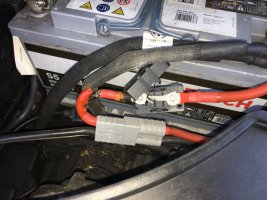You are using an out of date browser. It may not display this or other websites correctly.
You should upgrade or use an alternative browser.
You should upgrade or use an alternative browser.
Too Many OBDii Faults For My Liking!
Hello mmiYou should measure continuity of yellow/green wire all the way from the plug at battery to the plug at alternator.
So one side of the multimeter on the unplugged plug yellow/green at battery and the other side on the unplugged plug yellow/green at the alternator.
Please see another can attached taken after a short drive in the van today. Does your advice remain the same as above?
Attachments
Yes, I would start investigation with that.Hello mmi
Please see another can attached taken after a short drive in the van today. Does your advice remain the same as above?
Actually you could check that you see approx. 12 Volts at yellow/green wire at battery terminal and then check if the same 12 Volts can be found at the alternator end - see the wiring diagram earlier.
There is a download button/key at top right corner (under Tools menu) so you can download them on your computer as PDF's.For some reason the only browser I Ould get to open the files was Opera!
Many thanksYes, I would start investigation with that.
There is a download button/key at top right corner (under Tools menu) so you can download them on your computer as PDF's.
Yes I have downloaded now, just could get Firefox, Safari, Chrome or Edge to even open!
Some help please if anyone can oblige.
I finished the replacement of my leisure batteries and all of the wiring some time ago with help from many on the forum but mostly grim-reaper who has a similar set-up to mine. And i'm pleased to say it seems to have been most successful, and whilst on the couple of short journeys I have managed to make in the van since I have been amazed in the difference of how long the batteries last compared to the old set-up.
However I'm concerned that when I was giving the van a little service earlier today I noticed I have a very warm (almost could call it hot) positive lead! If you see the picture attached this is from the positive terminal to the Anderson connecter only, although after this is a little warm but I have put this down to probably just being heat transfer.
I can only assume that either my connection between the two ends of the Anderson connector is poor or one of my soldered terminals inside the Anderson connector has partially failed, both of which would surplice me as I'm pretty fuss! The fuse is 60A as recommended by Redarc who make the DC charger and I'm getting 14.6V to the leisure batteries which is spot on what it should be.
Any help of how to find out what's going on most appreciated.
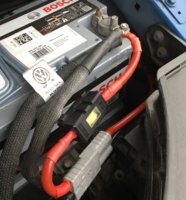
I finished the replacement of my leisure batteries and all of the wiring some time ago with help from many on the forum but mostly grim-reaper who has a similar set-up to mine. And i'm pleased to say it seems to have been most successful, and whilst on the couple of short journeys I have managed to make in the van since I have been amazed in the difference of how long the batteries last compared to the old set-up.
However I'm concerned that when I was giving the van a little service earlier today I noticed I have a very warm (almost could call it hot) positive lead! If you see the picture attached this is from the positive terminal to the Anderson connecter only, although after this is a little warm but I have put this down to probably just being heat transfer.
I can only assume that either my connection between the two ends of the Anderson connector is poor or one of my soldered terminals inside the Anderson connector has partially failed, both of which would surplice me as I'm pretty fuss! The fuse is 60A as recommended by Redarc who make the DC charger and I'm getting 14.6V to the leisure batteries which is spot on what it should be.
Any help of how to find out what's going on most appreciated.

Last edited:
Use a multimeter to measure voltage between actual battery positive terminal (the actual battery pole) and along the cable (fuse, connector, etc). It should show a significant reading across the heat source. Of course need to have load on to make current flow.
Depends what the current is - e.g. for 20 Amps voltage loss of 0.2 Volts between A to C would be something to be concerned about.
To feel something warm/hot means there could be 5 Watts of loss, which at 20 Amps would mean 0.25 Volt loss. 5W = 0.25V x 20A.
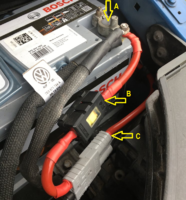
Across 60 Amp fuse alone I would expect to see about 0.02-0.04 Volts at 20 Amps.
To feel something warm/hot means there could be 5 Watts of loss, which at 20 Amps would mean 0.25 Volt loss. 5W = 0.25V x 20A.

Across 60 Amp fuse alone I would expect to see about 0.02-0.04 Volts at 20 Amps.
Thanks again mmi, I understand OK how to check for any loss of voltage along the cable but how is the amperage decided? Attached is the spec sheet of the Redarc (mine is the BCDC1240D) does this mean I assume the Redarc is drawing 40 Amps? Or will this depend on whether the charger is in maximum or float charge?
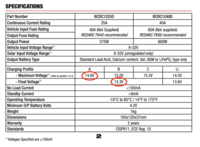

Yes, the current draw of the charger depends on it's operating mode, which depends on state of charge of the battery.
Better would be just to power up all everything you have, even bring in more 12 V gadgets - the more current draw the better. Then by measuring and comparing at different points along the line you should find the "hot spot" - siginificantly higher reading.
Better would be just to power up all everything you have, even bring in more 12 V gadgets - the more current draw the better. Then by measuring and comparing at different points along the line you should find the "hot spot" - siginificantly higher reading.
This problem may have been solved easier than we both expected 
When I took the top off the fuse holder to test look what I found after on picture below.
These midi fuses are obviously not fit for their intended purpose. I would be interested in others experiance of them. I have now replaced with a strip fuse.
Interestingly if I put the multimeter across the different parts of the cable in your positions A, b and C and don’t see any drop at all. I guess this means my connections are really good!
I ran the engine for 15 minutes and the cable stayed cool but I will run for longer when time allows.
Thanks for the help once again mmi
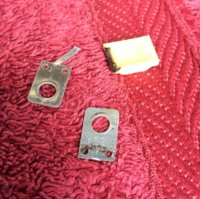
When I took the top off the fuse holder to test look what I found after on picture below.
These midi fuses are obviously not fit for their intended purpose. I would be interested in others experiance of them. I have now replaced with a strip fuse.
Interestingly if I put the multimeter across the different parts of the cable in your positions A, b and C and don’t see any drop at all. I guess this means my connections are really good!
I ran the engine for 15 minutes and the cable stayed cool but I will run for longer when time allows.
Thanks for the help once again mmi

Any news re the fault "02252"?Hello mmi
Please see another can attached taken after a short drive in the van today. Does your advice remain the same as above?
Hello and thanks for the interest.Any news re the fault "02252"?
Unfortunately in the current circumstances I'm having to stay away from home to care for others and don't really have the facilities or parking to investigate, but intend to when I get the chance to.
Could this have been caused by starting the van while the hookup cable was connected even though the CBE CB516 charger was switched to off on the face plate? You can probably guess I did this one day a week or so ago!
Another point worth making is I only came back from a 2 month round trip a few weeks back where a hookup cable wasn't possible, and as I was using the fridge all the time this couldn't have been burnt out then.
Another point worth making is I only came back from a 2 month round trip a few weeks back where a hookup cable wasn't possible, and as I was using the fridge all the time this couldn't have been burnt out then.
I see it, and it doesn't look good I must say!
Question is, did the small cable get hot, turn the insulation black and melt it for a while BEFORE the fuse blew or was it quick? Had you noticed anything wrong there before now?
It looks like there is an issue with that short length of cable between fuse and Anderson connector, maybe the tight bend has broken strands in the cable or the connection at the fuse end was not good and it resulted in a high resistance that has melted the cable.
The fuse holder bolt appears to have melted the plastic of the fuse holder which may have resulted in the fuse link breaking.
What do the contacts in the Anderson connector look like?
Question is, did the small cable get hot, turn the insulation black and melt it for a while BEFORE the fuse blew or was it quick? Had you noticed anything wrong there before now?
It looks like there is an issue with that short length of cable between fuse and Anderson connector, maybe the tight bend has broken strands in the cable or the connection at the fuse end was not good and it resulted in a high resistance that has melted the cable.
The fuse holder bolt appears to have melted the plastic of the fuse holder which may have resulted in the fuse link breaking.
What do the contacts in the Anderson connector look like?
My guess is poor crimping on the fuse end (of the short red cable). So the resistance in the connection caused a good voltage drop (=heat). Definitely a long time was needed to melt/burn insulation. Fuse was eventually blown by the heat, not sudden overcurrent.
Thanks for the quick reply
Didn't notice a thing before. Very good point about the curve which hadn't occurred to me
Surely the juice is coming from the other end so why didn't the fuse blow before the cable melted?!
When get a chance to strip it to bits will check. Guess I should be able to see if one or the other of the joints caused it
Didn't notice a thing before. Very good point about the curve which hadn't occurred to me
Surely the juice is coming from the other end so why didn't the fuse blow before the cable melted?!
When get a chance to strip it to bits will check. Guess I should be able to see if one or the other of the joints caused it
Just a thought - you haven't used/been supplied with Copper Clad Aluminium (CCA) cable in error, only mention this as some numbskull ripped me off by sending this instead of copper. It is difficult to get a good connection with this stuff - I tried then chucked it all in the scrap bin!
Similar threads
- Replies
- 19
- Views
- 1K
- Replies
- 24
- Views
- 10K
- Replies
- 12
- Views
- 2K

